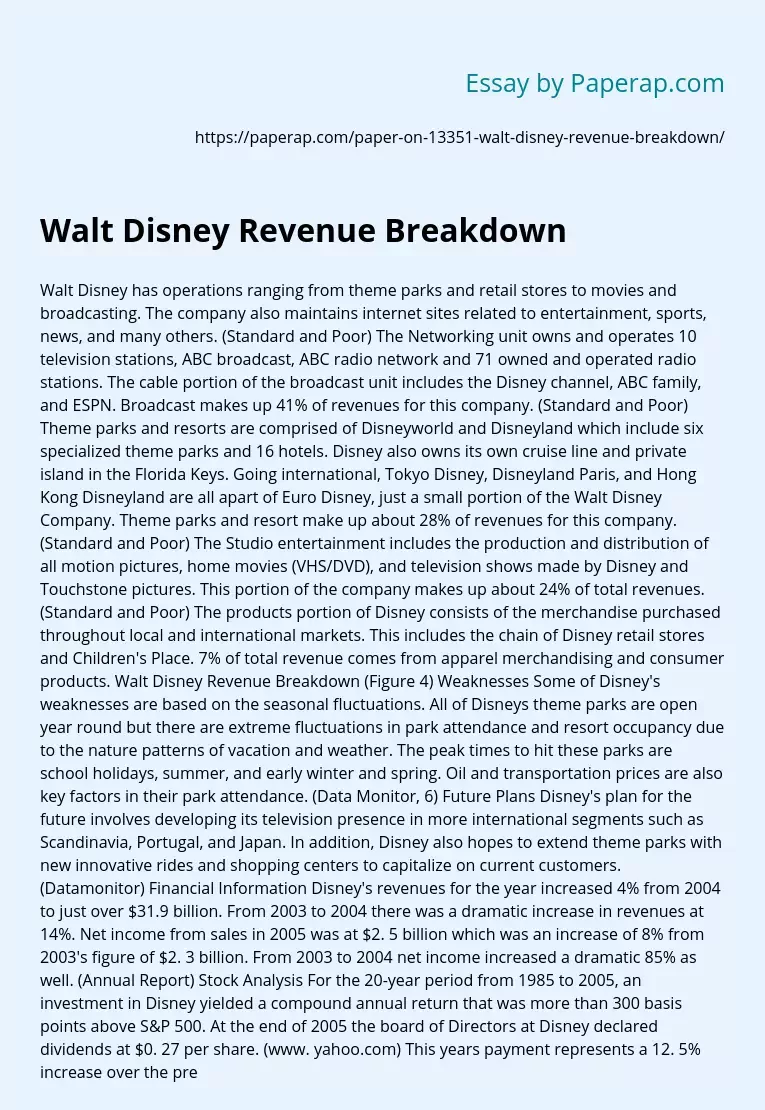Walt Disney Revenue Breakdown
Walt Disney has operations ranging from theme parks and retail stores to movies and broadcasting. The company also maintains internet sites related to entertainment, sports, news, and many others. (Standard and Poor) The Networking unit owns and operates 10 television stations, ABC broadcast, ABC radio network and 71 owned and operated radio stations. The cable portion of the broadcast unit includes the Disney channel, ABC family, and ESPN. Broadcast makes up 41% of revenues for this company. (Standard and Poor) Theme parks and resorts are comprised of Disneyworld and Disneyland which include six specialized theme parks and 16 hotels.
Disney also owns its own cruise line and private island in the Florida Keys. Going international, Tokyo Disney, Disneyland Paris, and Hong Kong Disneyland are all apart of Euro Disney, just a small portion of the Walt Disney Company. Theme parks and resort make up about 28% of revenues for this company. (Standard and Poor) The Studio entertainment includes the production and distribution of all motion pictures, home movies (VHS/DVD), and television shows made by Disney and Touchstone pictures.
This portion of the company makes up about 24% of total revenues.
(Standard and Poor) The products portion of Disney consists of the merchandise purchased throughout local and international markets. This includes the chain of Disney retail stores and Children’s Place. 7% of total revenue comes from apparel merchandising and consumer products. Walt Disney Revenue Breakdown (Figure 4) Weaknesses Some of Disney’s weaknesses are based on the seasonal fluctuations. All of Disneys theme parks are open year round but there are extreme fluctuations in park attendance and resort occupancy due to the nature patterns of vacation and weather.
The peak times to hit these parks are school holidays, summer, and early winter and spring. Oil and transportation prices are also key factors in their park attendance. (Data Monitor, 6) Future Plans Disney’s plan for the future involves developing its television presence in more international segments such as Scandinavia, Portugal, and Japan. In addition, Disney also hopes to extend theme parks with new innovative rides and shopping centers to capitalize on current customers. (Datamonitor)
Financial Information Disney’s revenues for the year increased 4% from 2004 to just over $31.9 billion. From 2003 to 2004 there was a dramatic increase in revenues at 14%. Net income from sales in 2005 was at $2. 5 billion which was an increase of 8% from 2003’s figure of $2. 3 billion. From 2003 to 2004 net income increased a dramatic 85% as well. (Annual Report) Stock Analysis For the 20-year period from 1985 to 2005, an investment in Disney yielded a compound annual return that was more than 300 basis points above S&P 500. At the end of 2005 the board of Directors at Disney declared dividends at $0. 27 per share.
This years payment represents a 12. 5% increase over the previous year. (Annual Report) The current price per share is $27. 09 a . 25 decrease from yesterdays close. The current amount of shareholders trading in Walt Disney Company is 11. 7 million people. From an analysts opinion, currently most consider Walt Disney Company to be a strong buy, they encouraged the shareholder to buy, or at least encourage them to hold the stock. Only three months ago, however, some suggested this stock was an underperformer in the market.
No analyst proposed to sell the stock. ANALYSIS After doing extensive research on both companies, I feel both of these stocks could be beneficial to your portfolio. However, looking at the chart below and analyzing the previous data, it seems that even though Walt Disney Corporation seems to bring in higher revenues and income, what seems to be the problem is that they keep redistributing for further projects in the broadcast and entertainment industry. Dividend payouts are not quite as high as Cedar Fair and it seems the fluctuation in the market is far too inconsistent.
Though Cedar Fair has had its ups and downs as far as weather and things of that nature, it seems by looking at the financial data from the annual report, noticing its increasing revenues, and innovative park renovations as well as the high dividend payouts and consistent price per share, this stock would be the better option for your company portfolio. Comparison of Walt Disney and Cedar Fair Stock (Figure 6) I would like to make my formal recommendation to Quam Securities regarding all of this research analysis. For a quick profit, Walnut Street Securities, Inc.suggests your company invest in the publicly traded stock Cedar Fair, L. P. (FUN).
I believe this will put Quam securities in the best position for a significant profit over the next few years. Cedar Fair has proven in the past that it is a trust worthy company and many analysts prefer to buy this specific investment. We appreciate your business with Walnut Street Securities, Inc. and hope you will seriously consider the information enclosed in this report. Our goal is to gain and build your trust as well as build you a fortune that you can be confident with.
Walt Disney Revenue Breakdown. (2018, Jan 25). Retrieved from https://paperap.com/paper-on-13351-walt-disney-revenue-breakdown/

